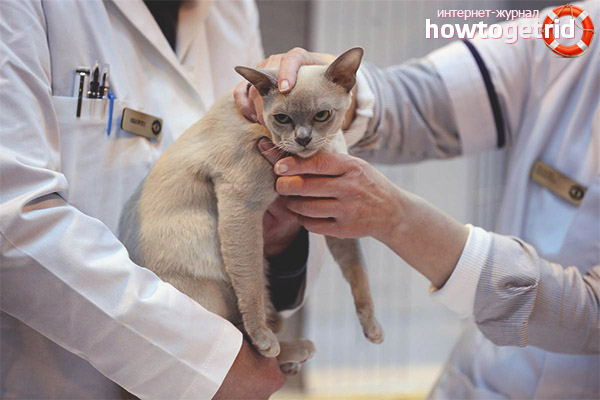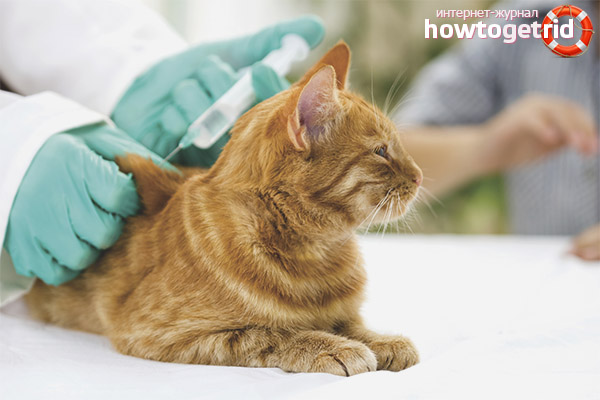The content of the article
Rabies is a deadly disease that affects all warm-blooded animals, including humans, which causes characteristic encephalitis. For several weeks, the causative agent of the disease may linger in the corpses of dead animals. The virus dies in conditions of heating the environment to 100 degrees, and during cooling it can remain active for another couple of years. Not resistant to 5% formalin, alkali or phenol solutions.
Can a cat get rabies?
Yes, any warm-blooded animal is rabid. Among the carriers of the disease are bats, wolves, hedgehogs, foxes and rodents. In urban conditions it is stray animals.
How can a cat become infected?
The virus is found in the saliva of an animal infected with rabies.A cat can get a virus by catching and eating a rodent with rabies or being bitten by a carrier. In the same way, a person can become infected. The next route of transmission of the virus is the saliva of an infected animal, which gets on the skin that has microcracks or mucous membranes in the body.
The period of incubation of rabies in cats is determined by the volume of virus in the cat's body, and also depends on the severity and location of the injury - the closer to the head is the bite, the faster the virus can get into the brain. Usually, the first manifestations of the disease occur two to three weeks after the injury. But it also happened that it took several months or even a year before the cat fell ill. Unfortunately, in cats, the rabies virus with saliva is released before the symptoms appear, so the likelihood of being infected for the owner and other pets is greatly increased.
How does a virus work?
After the rabies virus enters the body, it begins to move to the brain via pathways. Already from the brain, the virus is directed to the salivary glands, where its subsequent reproduction begins.This process is poorly understood due to complexity, so it is still unknown how neurons react to the effects of the virus. However, the result is known - a pet infected with rabies dies.
The clinical picture of rabies in cats
In cats, there are three different forms of the occurrence of rabies.
Exuberant
It is characterized by the passage of three stages: the prodromal stage, the stage of mania and the stage of depression. At the first stage, there are minimal changes in the nature of the animal and its habits: the animal goes to the owner, wants attention, licks the skin, rubs his head on the face of the owner and his hand. Sometimes cats are overly excited or, on the contrary, sleep too long and hide from daylight. There are difficulties with appetite, the cat sometimes gnaws inedible things. The animal is disturbed by diarrhea, diarrhea, and abundant salivation. Usually, the site of the injury worries the pet - it can be inflamed and often itches. This stage lasts from two to four days.
At the next stage, any signs of rabies infection in cats become much brighter. Salivation becomes so abundant that the hair near the mouth and on the cat's neck regularly become wet, crumpled and dirty. The cat is afraid of light and water, the lower jaw drops slightly.The animal does not take food and water, but sometimes swallows various objects. Habits become deprived of adequacy, the cat can even rush to the owner. It becomes difficult to calm an enraged animal, as in a cat infected with rabies, the logic of correct behavior disappears. Paralysis of the paws or larynx, or squint may develop. Sometimes cats leave the house, and then they can attack other animals or people.
This stage lasts about 3-5 days. And already at the third stage, the cat is constantly in an immobilized state due to paralysis of the paws, seizures may develop. As a result, the animal dies, being exhausted or after respiratory failure. It lasts no more than three days.
Paralytic form of the disease
It is characterized by an excessively rapid course, the state of health of a cat is sharply and significantly worsening, which leads to death in literally 3-4 days. The animal tries to hide in places deprived of light, does not take food and does not drink, the lower jaw is paralyzed quickly, subsequently paralysis of the hind and front paws and the body occurs. The cat does not show aggression, indifferently and neutrally perceives also its owner.
The least common is the atypical form of the disease. Among the characteristic symptoms of the disease: depression, general weakness and apathy, excessive drowsiness. The cat loses its appetite, sometimes vomiting or diarrhea, as well as diarrhea, sometimes tremor of different parts of the body is sometimes observed. The total duration of the development of the disease can reach several months. Rabies in kittens, in terms of manifestations and symptoms, is almost entirely similar to infection of adults, except for the only exception: in kittens the virus spreads faster, and the total duration of the disease is no more than a few days.
Diagnostic process

Alas, but to obtain material for analysis on infection with rabies is almost impossible as long as the cat is alive. The diseased animal is subjected to isolation for a certain time: usually up to twenty to thirty days. And if the cat dies, take the brain tissue for research on the presence in it of the pathogen virus.
Nowadays existing methods for studying the spinal fluid of a cat and its saliva make it possible to detect the presence of a virus even during the life of the animal, but even the absence of a positive result does not mean that the cat is not sick.Therefore, such tests are rarely used to diagnose rabies in cats.
Therapy
There are currently no therapeutic procedures for treating rabies in cats. Moreover, if a warm-blooded animal, including a human, has the first signs of a disease, it dies. In addition, it is prohibited to treat animals in which rabies is suspected, as it is an object of danger to medical personnel.
Therefore, even if rabies is detected in a cat in a timely manner, it will not be possible to save the pet. There are no effective drugs, so the animal is usually put to sleep. This choice is considered the most humane, because:
- Stops further spread of the virus, which can be transmitted very simply.
- The animal avoids the further agony and suffering that will inevitably come.
What to do if you suspect rabies in your pet:
- Initially, it will be necessary to subject the cat to isolation (close in a separate room, and in no case be in contact with the animal).
- Contact the nearest local veterinary clinic.
- If cat's saliva gets on the skin or the animal has bitten by the owner, it is necessary to thoroughly wash the injury area with running water in the running water using soap (best of all, as it is high in alkali).
It is important to know! If it was determined that the animal was infected with rabies, the owner would need to go to the hospital to conduct a special treatment. If you do not use this advice, it can turn into death. Remember that as soon as the first symptoms appear, the person is doomed to a terrible death!
Prevention of rabies in cats

The most reliable way to protect the cat from being infected with the rabies virus is, perhaps, timely and regular vaccination of the pet.
Please note! You can vaccinate against rabies for your pet at the municipal veterinary clinic for free, using the domestic vaccine. This option is accepted as mandatory throughout Russia. Animals that have not been vaccinated cannot participate in exhibitions with the owners, travel around the country and beyond.
For the first time a vaccine is given to another kitten at the age of 3 months or after the teeth have changed. An adult must be vaccinated once a year. Vaccination can only be put on a completely healthy animal that does not have parasites. A couple of weeks before the procedure, you need to offer your pet a worming medicine. Also, it is forbidden to vaccinate weak, diseased or pregnant cats.
Current vaccines do not have serious side effects and can be tolerated well even by a small kitten. The most common on the territory of the Russian Federation are these drugs: Nobivak, Rabikan, and also Kvadrikat.
Of course, it is important to prevent any contact of your pet with infected animals and carriers, but with the free keeping of a cat it is hardly possible.
Rabies is a real threat. Each year, more than 55,000 people die from the rabies virus throughout the world. Do not avoid or forget about prevention, citing the reluctance to get vaccinated with a low chance of getting sick.Even in the largest cities of the world, sometimes acute outbreaks of the disease occur, and the remoteness of an apartment or house from natural sites of infection does not guarantee that you are completely safe.
Video: the danger of rabies











To send